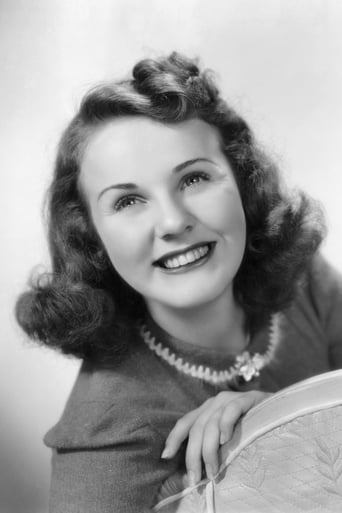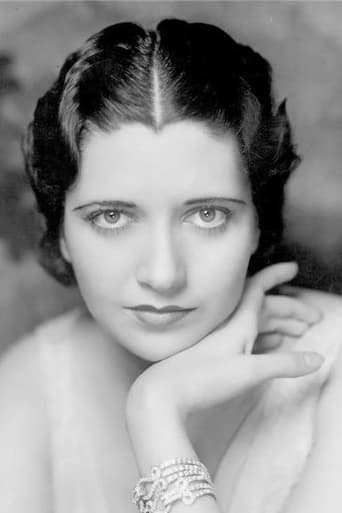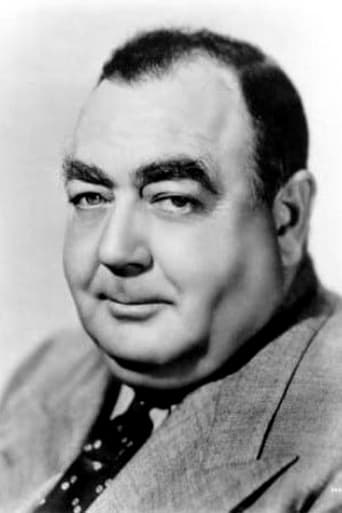FeistyUpper
If you don't like this, we can't be friends.
Beanbioca
As Good As It Gets
AshUnow
This is a small, humorous movie in some ways, but it has a huge heart. What a nice experience.
Verity Robins
Great movie. Not sure what people expected but I found it highly entertaining.
dougdoepke
The first part almost sparkles as Durbin sings and mixes with other youngsters. Then Pidgeon enters the picture and the movie bogs down in a romantic mix-up as implausibly an 18-year old Durbin and an adult Francis compete for the 42-year old male lead. Trouble is the movie stretches out the slender material, while director Seiter's pacing lacks needed snap. Nonetheless, Durbin's star quality comes through. Her more mature dramatic scenes are convincing for one so young. Still, I could have taken more of her usual bounce, while that last song (Ave Maria)-- of only three -- appears to have wandered in from another movie. I guess it's to reassure the audience of Durbin's basic innocence. All in all, the film fritters away its three outstanding performers with a lackluster script and pedestrian direction. Fortunately, they would all go on to better things.
kellyadmirer
This is a fine Deanna Durbin vehicle, but an uneven film. There are plenty of chances for Deanna to sing and be bubbly, enough to satisfy most fans, but the stars have to work overtime to keep what little drama exists moving until the inevitable resolution.Deanna is fledgling actress Pamela Drake, daughter of major Broadway star Georgia (Kay Francis). She works in a small regional theater but unexpectedly gets the chance to star on Broadway herself. Seeking seclusion in order to prepare for her big break, she heads home to Hawaii to spend some time with her mother. On the ship, she meets pineapple tycoon John Arlen (Walter Pidgeon), who first woos her but then also becomes interested in mama. It turns out that Georgia also expects to get the part already offered to Pamela and also wants John. Who gets the part? More importantly for these types of films, who gets the man?Durbin is amazing, as always, and really gets the chance to show what a child prodigy she was (though clearly becoming a young woman here). She sings several standards such as "Loch Lomond" and "Ave Maria" with her fine soprano voice, and shows maturity far, far beyond her years. If you aren't familiar with Durbin, be prepared to be dazzled by her talent. There's one fine bit where Deanna, trying to convince the big-time producers (including S.Z. Sakall doing his usual hammy bit) to hire her for their show, does several wildly different characterizations in rapid-fire succession which are all excellent. Great acting talent, great singing voice, prettier in a classic sense than Judy Garland, Deanna was the complete package.Pidgeon is great also, but he is up against formidable competition in the acting department here. He exudes his usual avuncular charm, and actually has some dashing moments on the ship to Hawaii as he tries to woo Pamela. Later, though, he appears bewildered at times, despite supposedly being the one in charge. Kay Francis is the clear loser. She is completely outclassed by Durbin, and is clad in weird fashions such as turbans that make her look dowdy and out of place, especially in a Hawaiian setting. It is difficult to believe that Arlen would choose her over Pamela. Plus, she is given almost no chance to do anything but sit and wait for John and Pamela to decide things for her, so her character and motivations are murky.Durbin gets to sing several times with her beautiful operatic voice, and she gets to emote repeatedly both as her own character and as the character she is playing within the story. Plus, she has several supremely Diva moments ("I am through with men!"), culminating in the glorious opportunity to stalk off in a huff, the battle won but the war lost. The reality, though, is that she is still just a kid playing in a grown-up world, a fight the real Deanna would be waging until she finally gave it all up and left films altogether later in that decade, hopefully for a happier life without the strain of constantly meeting her own and others' extraordinary expectations for herself.Ignore the story, but don't ignore Deanna, a true star.
fordraff
I watched this to see Kay Francis, who was coming to the end of her career here. Both she and Walter Pigeon were billed below the title; Deanna Durbin was the star, the only person billed above the title.This was the seventh movie Deanna Durbin made with producer Joe Pasternak and cameraman Joseph Valentine, and the well was running dry. This drivel would give anyone with an IQ above 70 a raging headache--even in 1940. It's a trite tale of a mother (Francis) and daughter (Durbin) in love with the same man (Pigeon) as well as mother and daughter vying for the same leading role in a Broadway play. It's nonsense with neither an ounce of plausibility nor a single bit of wit, though it fancies itself a comedy. The very contrived plot is arranged to provide Durbin with a ridiculous assortment of songs: "Musetta's Waltz" from La Boheme, Schubert's "Ave Maria," "Loch Lomond," and a bland new ballad, "Love Is All." Kay Francis was looking quite fine here, though the costume designer should have been shot for giving her unflattering turban hats.This was the first American film that S. Z. "Cuddles" Sakall appeared in, though he didn't have his nickname at that time. He was playing the sort of part here that he played throughout his Hollywood career.And the film reminded me of what an insipid actor Walter Pigeon was.
Brian Camp
Six films and four years after her auspicious starring debut in THREE SMART GIRLS (1936), the luster of Deanna Durbin began to dim, but just a little. In IT'S A DATE (1940), she's saddled with two high-profile grown-up co-stars, Walter Pidgeon and faded 1930s star Kay Francis, both of whom considerably slow down the normally hyperactive Deanna.The plot involves aspiring actress Deanna being offered a part that was originally promised to her stage diva mom (Kay). Then, in Hawaii, the plot shifts to a romantic triangle as the two women grapple, not for a part, but for the attentions of a pineapple tycoon, Pidgeon, who's more interested in the mother. The inherent drama in such a situation is jettisoned in favor of standard Universal Pictures sitcom antics. Kay Francis overacts but is never given any good lines, forced too often to simply react to the bubbly, aggressive Deanna.The first section of the film offers the flavorful ambiance of a theatrical milieu, both Broadway and regional theatre, but then, after Deanna's offered the part of St. Anne, the action shifts to a cruise ship, where Deanna meets Pidgeon, and finally to Hawaii where she reunites with Mom. Once Deanna boards the ship, she leaves behind her quirky boyfriend Freddy, an aspiring actor played by the funny Lewis Howard, who then disappears from the movie. Freddy has a great bit early on where he tries to impress a casting director by acting like a 'dope fiend' which is what he thought Deanna said when she told him to try out for the part of the Dauphin. He starts going into withdrawal tics, rubbing his nose and scratching his arms, a daring bit at a time when the Production Code strictly forbade drug references.Norman Krasna's script (from a 'story' credited to three writers) offers plenty of bright dialogue and funny bits, but the shifts in setting make it play like three movies crammed into one. William Seiter's heavy-handed direction seems more intent on showing off the lavish (for Universal) sets and less on showing off the actors, giving a bloated feel to the whole enterprise. Deanna's earlier films were leaner, zippier and bursting at the seams with youthful energy. The soundtrack is short on original songs and big on choral standards: Deanna's big numbers are 'Loch Lomond' and 'Ave Maria.'





